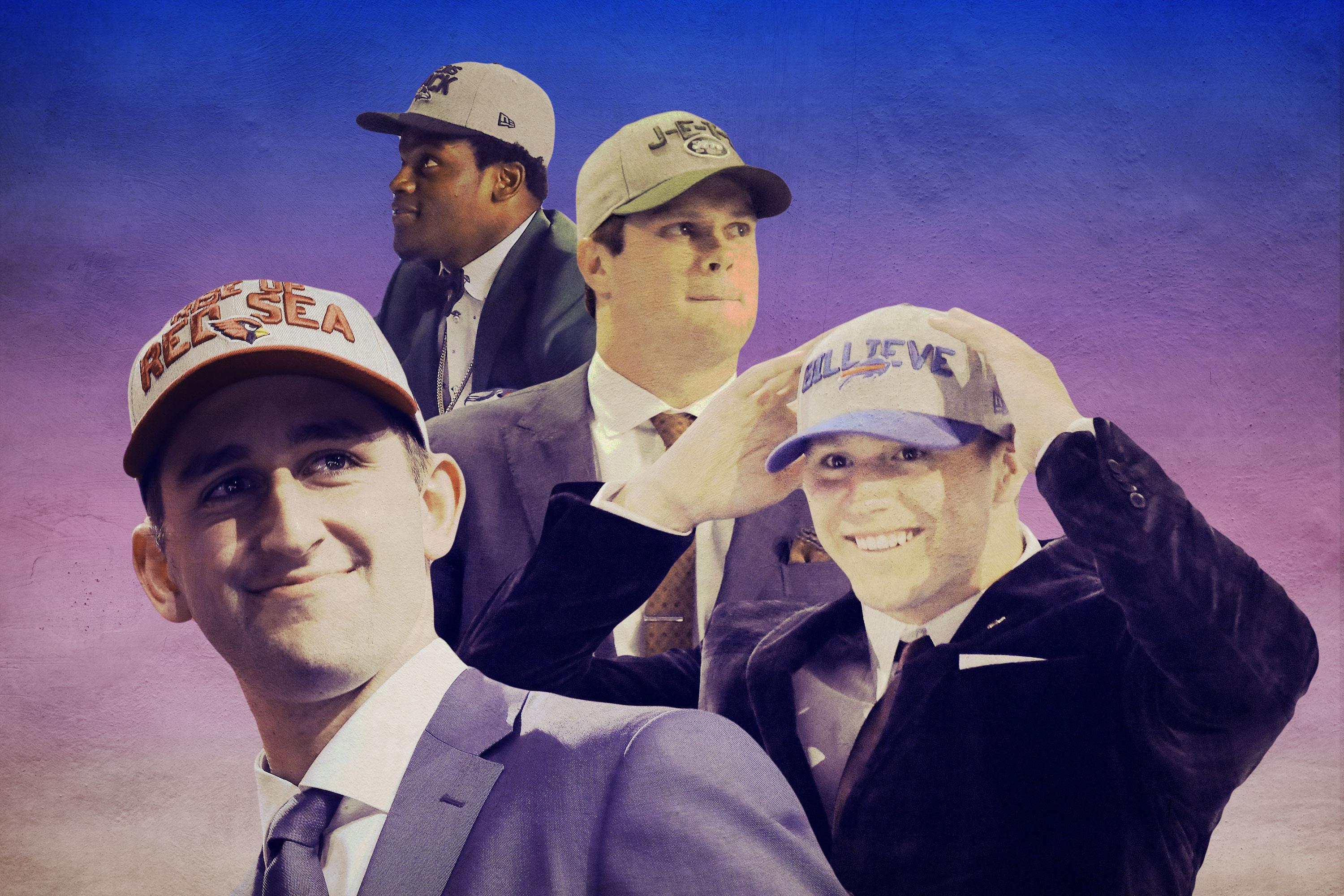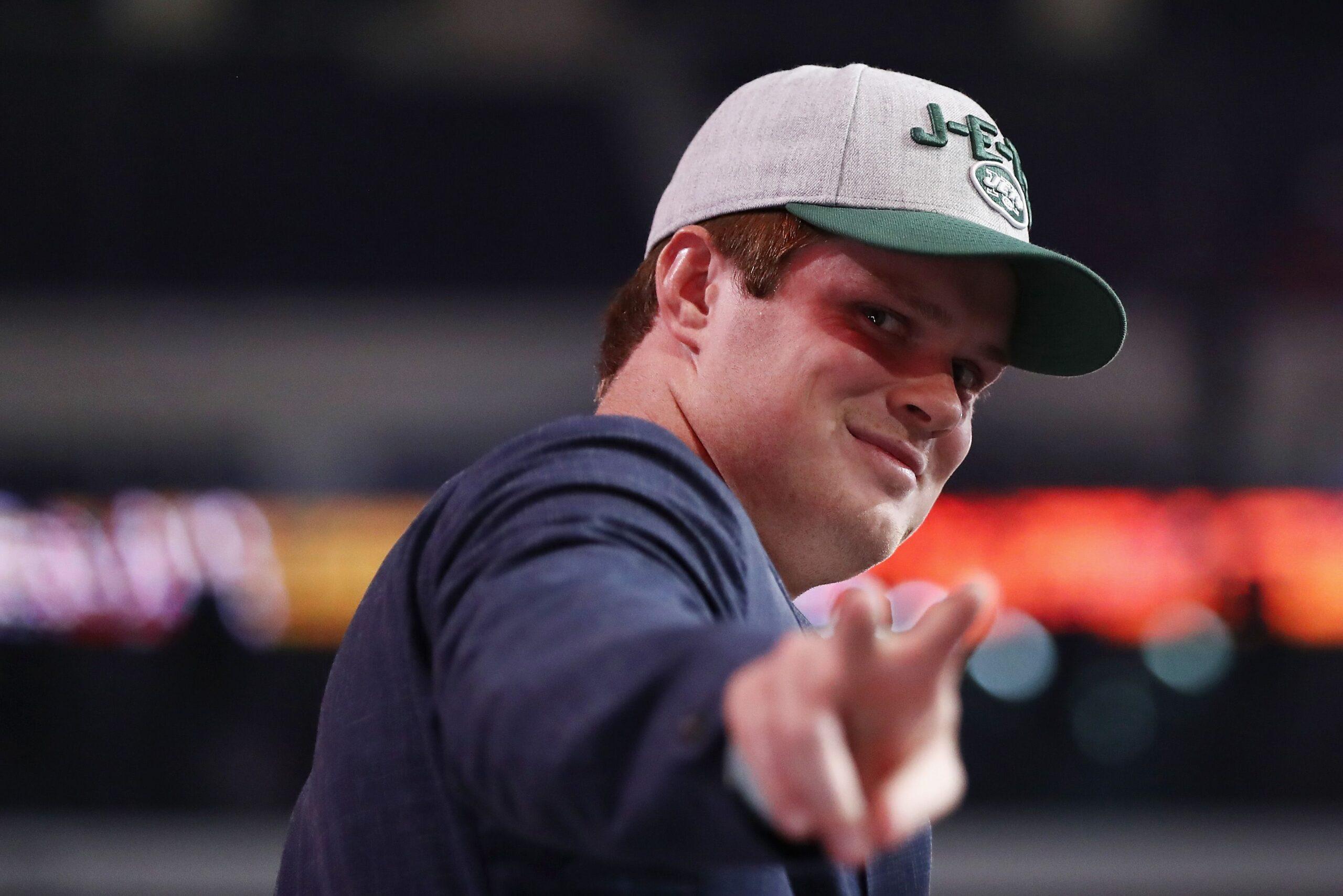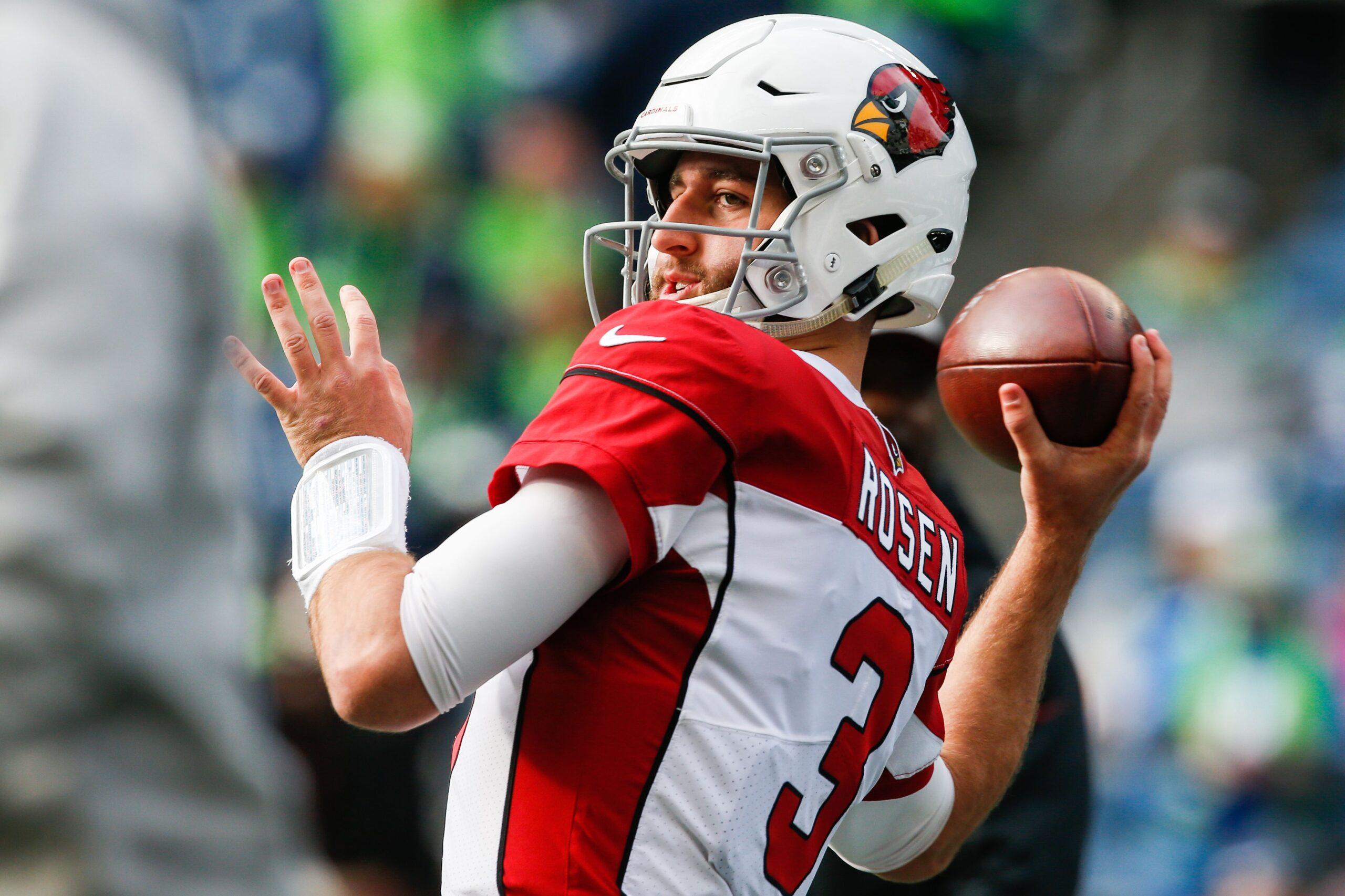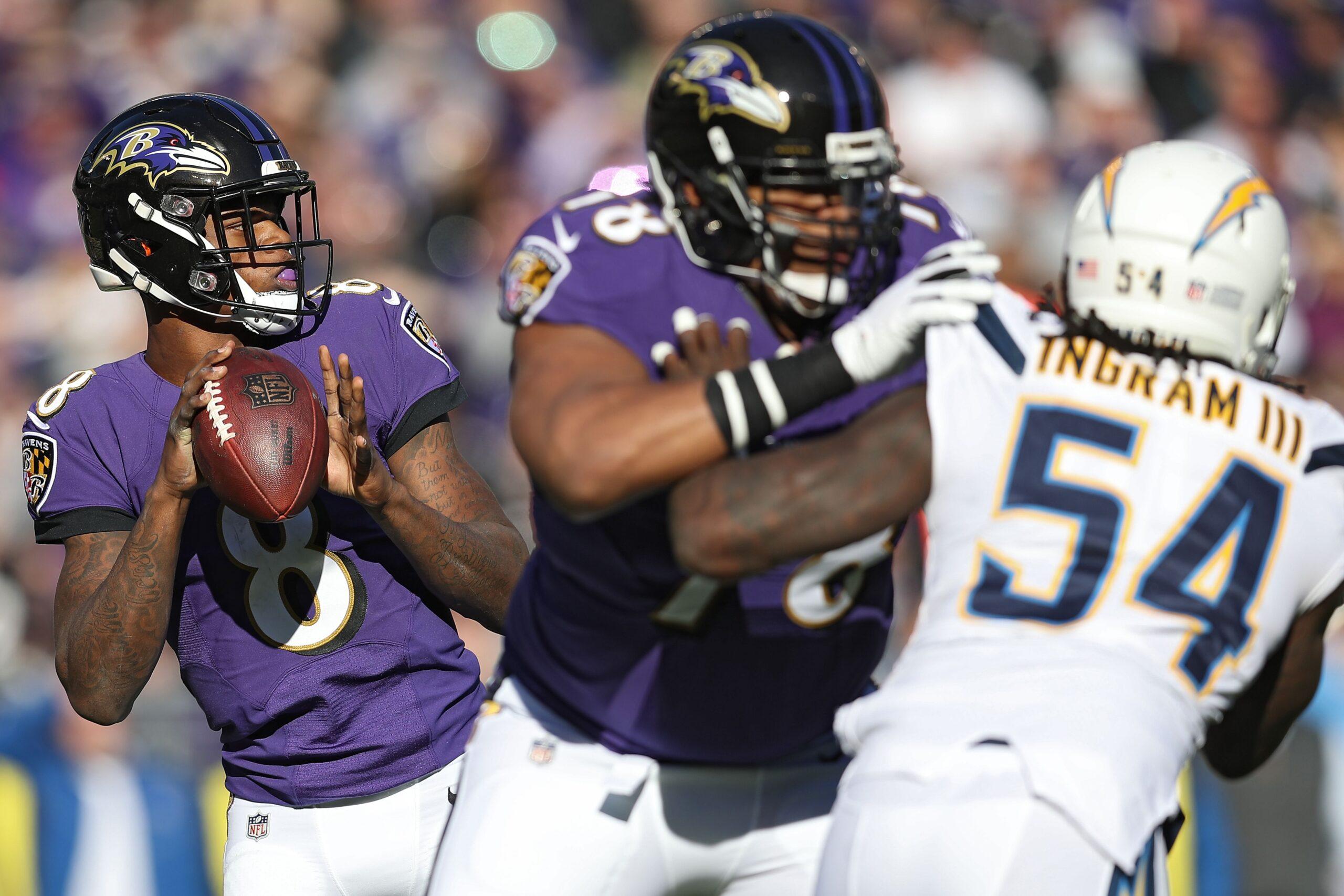
We are one week away from the 2019 NFL draft, and we’re neck high in mock drafts. But there are two problems with mocks: The order of the teams always changes due to trades, and the order of players picked is always wrong. These two problems stem from one bigger problem: Predicting the future is quite difficult. However, looking back at the past and judging with the omniscient power of hindsight is much, much easier. It’s also significantly more fun. So rather than telling you which teams will draft which player next week, let’s look back at the teams who made trades in the first round of last year’s draft and decide which teams did well, which teams did poorly, and which team screwed up.
We’re judging the value of the trade and how the teams involved used the picks involved. We’re nitpicking how much teams paid for their groceries and how good the meal tasted with one grade.
The Sam Darnold Trade
Jets Received: No. 3 overall (Sam Darnold)
Colts Received: No. 6 overall (Quenton Nelson), no. 37 (Braden Smith), no. 49 (traded to Philadelphia), 2019 second-rounder (no. 34 overall)
Jets: New York gave up three second-rounders in order to move up three spots. It was a lot, but they’re lucky the Giants passed on a quarterback at no. 2 overall, because Darnold seems to have been worth it. He looked like the second-best rookie quarterback, after Baker Mayfield, last season, though his career briefly became a meme when he threw a pick-six on his first pass attempt on Monday Night Football and every Jets fan had their fandom flash before their eyes. But the Jets rallied and crushed the Lions to avoid giving Darnold an ignominious beginning to his career.

That game is kind of representative of how Darnold’s season went. The beginning was tough—real tough. He cracked 200 yards passing in a game once in the first five weeks of the season and suffered a foot injury in November that kept him out for a month. But when he returned, it seemed the game had slowed down for him: Darnold was the highest-rated quarterback in the final month of the season by ESPN’s Total QBR. He still has tough habits—his footwork can be sloppy, which messes up his rhythm on deeper routes, and his situational awareness could improve—but he’s still young. Darnold is 21, born in June 1997—a month after Dwayne Haskins and two months before Kyler Murray. He still has plenty of room to grow. The Jets got a good one.
Grade: B+
Colts: Indy got three second-rounders in exchange for moving down three spots, still got the best offensive lineman in the draft in Notre Dame’s Quenton Nelson and then used New York’s second-rounder to draft Braden Smith, whom it plugged in at right tackle. Indy trusted two rookies in remaking its offensive line last year, and the Colts had perhaps the best pass protection in the entire league. Andrew Luck was sacked on a league-low percentage of his dropbacks (2.7 percent). More importantly, Nelson made offensive linemen cool by pancaking dudes while being mic’d up. How many guards can you name who don’t play for your favorite team? Quenton Nelson is already the most famous guy at his position. It’s hard to see how this deal could have gone better for Indy.
Grade: A
The Josh Allen Trade
This one happened in two parts:
Bills Received: No. 12 overall (traded to Tampa Bay), No. 187 overall (Ray-Ray McCloud)
Bengals Received: No. 21 overall (Billy Price), no. 158 overall (Andrew Brown), Cordy Glenn
Bills Received: No. 7 overall pick (Josh Allen)
Buccaneers Received: No. 12 pick (Vita Vea), no. 38 (Ronald Jones II), no. 53 (M.J. Stewart)
Bills: Josh Allen is a human Rorschach test. Everyone sees the cannon arm, surprising hurdle ability, and occasional inability to complete passes within 10 yards of the line of scrimmage, but some think he was worthy of the first overall pick, while some (me!) doubt whether he was worth a first-round pick. Admittedly, Allen played far better than his doubters (me!) thought he would in 2018. In games Allen played, the Bills went 5-7, which is almost impressive considering how bad Buffalo was otherwise. His completion percentage is still a massive concern—52.8 percent on 320 attempts is almost exactly Shaquille O’Neal’s career free throw percentage. Buffalo traded tackle Cordy Glenn to Cincy in order to move up nine spots a month before the draft and then moved up five spots on the day of the draft to get Allen. On one hand, trading Glenn was wise. If Buffalo had made one big jump instead of two small ones, it likely would have had to sacrifice a future first-rounder. On the other hand, Allen was sacked on 8.0 percent of his dropbacks, one of the highest rates in the league. Despite that, Allen proved he is better than his worst-case scenario, but that’s a low bar to clear, and he clears Barrs when they go low.
Grade: B-
Bengals: Cincinnati’s offensive line was in rough shape heading into the 2018 offseason, so picking up a starting tackle in exchange for moving back nine spots and then using the first-rounder on a center to bolster the unit was wise. Glenn was fine for the Bengals, and getting a fine starting tackle who is under contract through 2020 for less than $10 million a year is pretty good in a world where the Raiders made former Patriot Trent Brown the highest-paid offensive tackle ever a year after New England scooped him up from the 49ers for a third-rounder. Price didn’t have an excellent rookie season, either, though they get a partial mulligan for the time Andy Dalton missed and was replaced by Jeff Driskel.
Grade: B-
Buccaneers: The Bucs got good value to move back five spots, but they may have blown the picks. They used the no. 12 pick on defensive tackle Vita Vea, who was limited to start the year by a July calf injury, debuted in Week 4, and then had 3.5 tackles over the next seven games. He will hopefully be much healthier in 2019, but even then he has a long way to go to develop the pass-rush moves necessary to contribute as a three-down player.
Vea had a bad rookie year, but second-rounder Ronald Jones was a borderline disaster. He started the year as a healthy inactive. A second-round pick being held out without an injury is yikes. He eventually got playing time, but rushed for just 44 yards on 23 attempts (1.9 yards per carry). To put that in perspective, only four players last year with 20 or more carries earned less than 2 yards per carry: Derek Carr, Tom Brady, Drew Brees, and Jones. Perhaps Tampa Bay could point to its offensive line as an issue, but the team just gave left tackle Donovan Smith $27 million guaranteed over two years to stay and paid guard Ali Marpet $21.1 million guaranteed on a five-year deal. If the Bucs felt their offensive line was the issue, it’s certainly strange that they went out of their way to keep the group together.
Grade: D
The Josh Rosen Trade
Cardinals Received: No. 10 overall (Josh Rosen)
Raiders Received: No. 15 overall (Kolton Miller), no. 79 overall (traded to the Steelers for Martavis Bryant), no. 152 (traded to Tennessee)
Cardinals: Life is funny. A year ago, this looked like the best value pick in the entire draft. The Cardinals gave up a third- and a fifth-rounder to leapfrog five spots and take their franchise quarterback—what’s not to love about that?

Josh Rosen, apparently. The Cardinals are expected to take Oklahoma quarterback Kyler Murray with the no. 1 overall pick in this year’s draft. Arizona may trade Rosen during the draft as a result, or wait, carry both quarterbacks into the season, and see whether a team is interested in a trade later on. If the Cardinals flip Rosen for another first-rounder, all is not lost, and this might just be one of those funny stories that serves as the prologue to how you found your soulmate and settled down. But just because things work out doesn’t mean you were making good decisions beforehand. Sometimes you get lucky.
Grade: Due date extended
Raiders: If you think the Rosen deal is funny in retrospect, this side is a trip. The Raiders flipped this third-round pick to Oakland for Martavis Bryant. The Bryant trade was an abject disaster. Bryant was waived before the season began, re-signed with Oakland, caught 19 passes for the team across eight games, and was suspended indefinitely by the league in December for violating the terms of his reinstatement from a previous ban under the league’s substance abuse policy. Jon Gruden trading a third-round pick for Bryant is a window into what happens when Gruden loses his fidget spinner.
Less than a year later, the Raiders traded their 2019 third-rounder plus a fifth-rounder to Pittsburgh for Antonio Brown. (The Brown deal has no impact on Oakland’s grade here. It’s unrelated. It’s just absolutely bonkers to consider that the Raiders traded a third-rounder for Bryant in April 2018 and then sent a third- and a fifth-rounder to get Brown 10 months later.)
Still, the Raiders completely squandered the third-rounder from Arizona, so the first-rounder is their only chance to salvage the grade. But after one year, it seems like they may have made the wrong pick. Kolton Miller struggled in his rookie year (to be polite). Out of 80 tackles who played enough snaps, Miller was graded 76th, according to Pro Football Focus. It could be tempting to say it was because he was a rookie, but among the 85 offensive tackles who played 400 or more snaps in their rookie year since PFF began grading in 2006, Miller was 81st overall and last in run-blocking grades. Injuries certainly played a huge part, but Miller was hurt entering the draft. Hopefully his play improves in a healthier 2019.
Grade: D
The Lamar Jackson Trades
Baltimore traded back in the first round twice before trading up.
Bills Received: No. 16 overall (Tremaine Edmunds), no. 154 (Siran Neal)
Ravens Received: No. 22 (traded to Tennessee), no. 65 (traded to Oakland)
Ravens Received: No. 25 overall (Hayden Hurst), no. 125 overall (traded to Philadelphia)
Titans Received: No. 22 overall (Rashaan Evans), no. 215 overall (traded—back to Baltimore!)
Ravens Received: No. 32 overall (Lamar Jackson), no. 132 overall (Jaleel Scott)
Eagles Received: No. 52 overall (traded to Indianapolis), no. 125 overall (Avonte Maddox), 2019 second-rounder (no. 53 overall)
Ravens: The Ravens made a few deals to move back that culminated in the team taking tight end Hayden Hurst and then trading up to get former Heisman winner Lamar Jackson with the last pick of the first round. Plugging in Jackson after their bye saved the Ravens’ season. They finished on a 6-1 run, snagged the NFC North title, saved John Harbaugh’s job, and completed their succession plan in the final two months of their season. Jackson’s rookie season was clearly a success. It also ended by reinforcing every predraft concern about him. Baltimore was eviscerated by the Chargers in the wild-card round, and as tempting as it is to wash away Jackson’s struggles as just one playoff game, or to shift the blame to the coaching staff, the Chargers highlighted Jackson’s weaknesses. As Jackson himself said this week:

“[Mechanics] had a lot to do with it,” Jackson said. “I was probably getting lazy, trying to make things happen with just my arm and not following through with my legs, and it showed a lot. I would throw an inaccurate ball.”
Unless he fixes those things, 2019 will be a lot more like the Chargers game than the final seven games of the regular season.
Grade: B-
Bills: Trading up looks wise. Trading up and not taking Derwin James—who went to the Chargers with the next pick—already looks foolish, even though Edmunds is a strong player.
Grade: B
Eagles: Philly picked up an extra second-rounder for its troubles and added Dallas Goedert, who served as an excellent complement to tight end Zach Ertz (though the Eagles are docked points for drafting a person named after a division rival). As 11 personnel (one running back, one tight end, three wide receivers) has become the standard formation and defenses have shifted their personnel accordingly, there has been an opening for 12 personnel (one running back, two tight ends) to create mismatches. When they were on the field together Ertz and Goedert were hard to stop in 2018, and their presence takes some of the pressure off of the Eagles offensive line. The Eagles used 12 personnel 36 percent of the time, the second-highest rate in the league, according to Sharp Football Stats.
Grade: B+
Titans: Sure, why not?
Grade: Pass
Packers Trade Down With Saints …
Packers Received: No. 27 overall (traded—hold that thought), no. 147 overall (traded to Carolina), 2019 first-rounder (No. 30 overall)
Saints Received: No. 14 overall (Marcus Davenport)
Saints: New Orleans is the epitome of a short-term-minded team. Last year, the Saints traded a third-rounder for Teddy Bridgewater in August when they could have signed him in March. Here, they traded their 2019 first-rounder for the right to pick Davenport, which might have been called short-sighted had they not nearly made the Super Bowl. Davenport didn’t light it up for the Saints, as he had just 4.5 sacks, six tackles for loss, and 12 QB hits as a rookie. Yet the Saints needed a pass rush and got one, even if their strategy was flawed.
Grade: C+
… Then Trade Up With Seahawks
Packers Received: No. 18 overall (Louisville CB Jaire Alexander), no. 248 overall (Kendall Donnerson)
Seahawks Received: No. 27 overall (Rashaad Penny), no. 76 overall (traded to the Steelers), No. 186 overall (Jacob Martin)
Packers: Green Bay crushed the draft in the moment, and it only looks better in retrospect. The Packers netted what looks to be the second-best cornerback (behind Denzel Ward) in the class in Jaire Alexander while also picking up another first-rounder this year. Green Bay certainly could have snagged Alexander at no. 14, but the team moved back five spots, added more draft capital, and still got a difference-maker.
Grade: A-
Seahawks: Seattle moved down nine spots and took a running back in the first round. Penny’s rookie season was an up-and-down-and-down affair. He was beaten out for the job by Chris Carson, a seventh-round pick in 2017 who broke his leg his rookie season. Penny had more than nine carries in a game twice, in Week 2 and in Week 9, and he surpassed more than 49 rushing yards twice. Meanwhile, the running backs taken behind him included Nick Chubb, Sony Michel, and Derrius Guice. Seattle flipped the third-rounder to pick up a seventh-round pick and move back three spots from no. 76 to no. 79, where the team selected USC defensive end Rasheem Green, who had one sack in 10 games. Unless Green becomes a significant part of Seattle’s pass rush, it’s not much value for trading back. Even if Penny improves this year, it’s tough to see how Seattle is better off with Penny and Green instead of hanging onto the 18th pick and taking someone better there.
Grade: C

